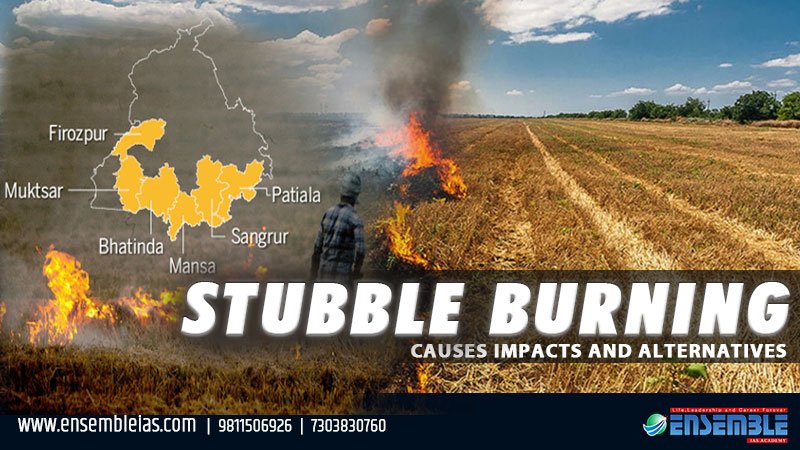What is Stubble Burning?
 Stubble burning refers to the practice of burning the kharif crop of paddy’s residue to prepare the field for the Rabi crop. Stubble burning has been a cause of severe air pollution in the month of September-October in Delhi NCR Region.
Stubble burning refers to the practice of burning the kharif crop of paddy’s residue to prepare the field for the Rabi crop. Stubble burning has been a cause of severe air pollution in the month of September-October in Delhi NCR Region.
Majority of the stubble burning takes place in the states of Punjab and Haryana along with parts of western Uttar Pradesh.
Impact of Green Revolution
On the aftermath of Green Revolution resulting in the efforts of gaining food security in the country, agriculture saw a shift in Punjab and Haryana, where farmers switched to grow paddy from coarse grains.
Highly subsidized electricity, to operate tubewells to fulfill the irrigation requirements, was provided apart from other infrastructural infra-structural backups.
Since this shift, bumper harvest of rice crop was seen, adding further to the food security of the nation.
The Negative Impact due to increasing faulty practices
On the one hand where this came at a cost of falling water tables, increased practices of monoculture and using of more chemical fertilizers and pesticides than required.
On the other hand, heavy air pollution was created due to the burning of stubble.
Reasons of Stubble Burning
Farmers been burning stubble due to various reasons:
- It provides them a quick solution to get rid of the paddy residues, which stay in the field after the crop is harvested using combined harvester.
- Since other methods like, the manual removal and feeding it to the cattle is another challenge due to high silica content.
 How the Pollution by Stubble Burning Affects Human Health
How the Pollution by Stubble Burning Affects Human Health
Stubble burning produces particulate matter PM 10 and PM 2.5 which is detrimental to the human health as its effects lungs, causes bronchial asthma, heart strokes, etc. PM enter the bloodstream and causes disease.
Attempts to Address the Issue
There have been persistent studies and attempts to address the issue like reducing the area under paddy or to stop the subsidies on electricity.
During the coronavirus containment lockdowns various farmers opted the direct seeding of rice, due to lack of labour for transplantation. This is a viable alternative as the direct seeded rice requires less water and provides the lesser harvesting tenure.
This facilitates a period 20 to 25 days window to prepare fields for the next crop. This method may be used where farmers need not require burning the stubble.
Recently, PUSA Decomposer Technique is being hailed as a solution of the stubble burning. It is a set of 4 capsules, which is prepared by extracting fungi strains. When mixed with water and sprinkling it causes the straw to decompose at a faster rate. This way it not only solves the need to burn the stubble but also help in increasing the fertility as well as humus in the soil.
Time has come when sustainable practices, rational decisions must be adapted to pass the benefit of nature to the future generation while fulfilling today’s needs.
Author:- Suramya Sharma
Stubble burning: Causes Impacts and Alternatives
For more details : Ensemble IAS Academy Call Us : 98115 06926, 7303830760
Email: ensembleias@gmail.com
Visit us:- https://ensembleias.com/
#Stubble_burning #Farmers #air_pollution #kharif_Rabi_crop #PUSA #Delhi_NCR_Region #Ecological #Cultural #Economic #Historic #Geologic_Evolution #blog #geography_optional #upsc2020 #ias #k_siddharthasir #Government_of_India #india #studyabroad #geography #upsc #bhugol #government #news #dailynews #gk #dailyquiz #editorial
